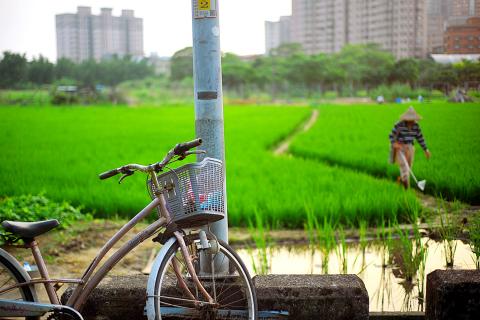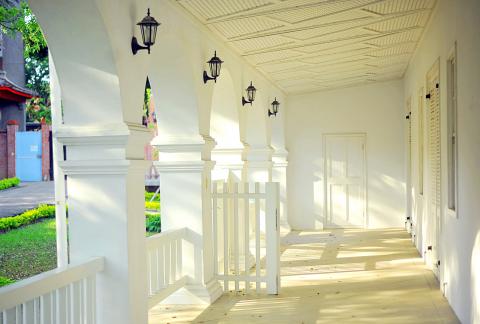Staring at the Tamsui waterfront from a hill, all I can see is a never-ending sea of people. I get that people here like crowds, but it’s still a bit perplexing that my friend and I are the only people on this narrow, winding stone-paved path. With the noise blocked off by the buildings and trees, it’s completely quiet, making it even harder to believe that this is just two streets away from the chaos below.
I’ve been to Tamsui countless times since high school, but somehow every time I would simply follow the crowds from the MRT station and dive straight into Tamsui Old Street (淡水老街), which is lined with shops, stalls and performers. I was a bit embarrassed when I spoke to a granddaughter of a former British consul in Tamsui and admitted that I had never visited any of the historic sites there.
AWAY FROM CROWDS

Photo: Han Cheung, Taipei Times
On a fine Sunday afternoon, I visited Tamsui again but head in a totally different direction from the usual route. Exiting the MRT, I follow the tourist-laden Zhongzheng Road (中正路) until I make a right at alley 129 and walk up a hill to Chingshui Temple (清水巖). Miraculously all the tourists have disappeared. From here, there are a series of steep footpaths that take visitors through crumbling old brick houses and overgrown greenery.
The paths eventually lead to Zhongjian Street (重建街), a picturesque sloped path with some interesting shops, including Herbs Maison, housed in a 100-year-old residence and holds various herb workshops and historical tours. There’s a quaint alley surrounded by abandoned buildings dubbed Love Lane (戀愛巷). According to local lore, Tamsui doctor and writer Wang Chang-hsiung (王昶雄) would pass through this alley when walking home his future wife Lin Yu-chu (林玉珠). With its cute decorations, all signs point to a tourist draw tailored for selfies, but it is pretty and there are still few people around.
Don’t rush to the main street just yet, because there are some more narrow alleys to explore here. Most don’t really take you anywhere, but there’s a certain charm to them. Chungjian Street ends at Wenhua Road (文化路), the main thoroughfare for this area. At the intersection I see a poster for a cultural tour of Tamsui’s public bathrooms organized by the Taiwan Toilet Association (台灣衛浴文化協會), that runs until Tuesday.

Photo: Han Cheung, Taipei Times
I cross the road and walk up Chenli Street (真理街), another hardy slope, and pass two shops that both claim to be the original stores selling agei (阿給), or fried tofu stuffed with glass noodles and sealed with fish paste. I make a u-turn and walk down another pleasant, stone-paved path to the former residence of Tada Eikichi, mayor of Tamsui from 1930 to 1933. It’s a renovated traditional Japanese house that sits in a large, beautiful garden. Part of the charm is that it’s entirely open-air, with all windows and doors ajar.
PLENTY FOR HISTORY BUFFS
I follow the path along the residence walls, lined with red brick and greenery. It is the last moment of solitude for the time being, as the next area is swarmed with South Korean tourists. Apparently, the movie Secret (不能說的秘密) starring Jay Chou (周杰倫) was filmed here at Aletheia University (真理大學). Somehow it was a huge hit with the Koreans and they flock here en masse to see the school grounds containing buildings that are a hybrid of Western and local styles.

Photo: Han Cheung, Taipei Times
Before entering the university, I check out the residence of the former tax division customs during the Qing Dynasty, also known as the Little White House (小白宮). The verandas with white columns are great for photos, but it was crowded and I quickly left. Aletheia University is a joy to walk through, as picturesque scenes abound. University founder and famous missionary George Leslie Mackay’s former residence is located here, and has only been open to the public since May of last year. Unfortunately, it’s closed on Sundays, but it’s possible to find an isolated corner on the veranda and enjoy a moment of reflection surrounded by white columns, white walls and white doors.
The next destination is Fort San Domingo and the adjacent former British Consular Residence, two famous historical sites in Tamsui that require no introduction. But at least, as a history buff, I won’t feel embarrassed about never visiting these sites anymore.
Continuing down Zhongzheng Road, I visit the Drop of Water Memorial (一滴水紀念館), a traditional Japanese house that was moved from Japan to Taiwan over five years as a symbol of the friendship between the two countries. It wasn’t very spectacular as far as Japanese residences in Taiwan go. Nearby is Hobe Fort (滬尾砲台). I’m a big fan of visiting historical forts, and this is by far the most complete experience as the fort is pretty much intact. The route takes visitors through the various tunnels to the top of the fort and back inside, and the entire structure is explorable. It’s almost like a castle, and I could have probably spent hours here if I didn’t arrive half hour before closing.

Photo: Han Cheung, Taipei Times
For those who still have energy after walking this far, there’s a final treat waiting further down Zhongzheng Road that I discovered by accident. On a whim, I hung a right at alley 22, only to discover a sleepy, somewhat decaying residential neighborhood that looks like it belongs to another era. The cement houses abruptly end after a few minutes of walking, revealing an expanse of lush rice paddies. I followed a path into the greenery along a small canal, which was dotted with old folks tending to their vegetable plots. A few dogs and scooters buzz by, and there’s a couple taking wedding photos in the middle of the field. I watch the sunset here, and I forget that the massive crowds are still just a couple blocks away.
If you go:
Tada Eikichi Residence
19 Mackay St, New Taipei City (新北市馬偕街19號)
Open 9:30am to 5pm weekdays, 9:30am to 6pm weekends, free admission
George Leslie Mackay Residence
2, Ln 4, Chenli St, New Taipei City (新北市真理街4巷2號)
Open 10am to 4pm Tuesday to Saturday, free admission
Hobe Fort
34, Ln 6, Zhongzheng Rd Sec 1, New Taipei City (新北市中正路一段6巷34號)
Open 9:30am to 5pm weekdays, 9:30am to 6pm weekends, admission is NT$80 (includes entry to Fort San Domingo and the Little White House)

Last week the story of the giant illegal crater dug in Kaohsiung’s Meinong District (美濃) emerged into the public consciousness. The site was used for sand and gravel extraction, and then filled with construction waste. Locals referred to it sardonically as the “Meinong Grand Canyon,” according to media reports, because it was 2 hectares in length and 10 meters deep. The land involved included both state-owned and local farm land. Local media said that the site had generated NT$300 million in profits, against fines of a few million and the loss of some excavators. OFFICIAL CORRUPTION? The site had been seized

Next week, candidates will officially register to run for chair of the Chinese Nationalist Party (KMT). By the end of Friday, we will know who has registered for the Oct. 18 election. The number of declared candidates has been fluctuating daily. Some candidates registering may be disqualified, so the final list may be in flux for weeks. The list of likely candidates ranges from deep blue to deeper blue to deepest blue, bordering on red (pro-Chinese Communist Party, CCP). Unless current Chairman Eric Chu (朱立倫) can be convinced to run for re-election, the party looks likely to shift towards more hardline

The depressing numbers continue to pile up, like casualty lists after a lost battle. This week, after the government announced the 19th straight month of population decline, the Ministry of the Interior said that Taiwan is expected to lose 6.67 million workers in two waves of retirement over the next 15 years. According to the Ministry of Labor (MOL), Taiwan has a workforce of 11.6 million (as of July). The over-15 population was 20.244 million last year. EARLY RETIREMENT Early retirement is going to make these waves a tsunami. According to the Directorate General of Budget Accounting and Statistics (DGBAS), the

Sept. 15 to Sept. 21 A Bhutanese princess caught at Taoyuan Airport with 22 rhino horns — worth about NT$31 million today — might have been just another curious front-page story. But the Sept. 17, 1993 incident came at a sensitive moment. Taiwan, dubbed “Die-wan” by the British conservationist group Environmental Investigation Agency (EIA), was under international fire for being a major hub for rhino horn. Just 10 days earlier, US secretary of the interior Bruce Babbitt had recommended sanctions against Taiwan for its “failure to end its participation in rhinoceros horn trade.” Even though Taiwan had restricted imports since 1985 and enacted